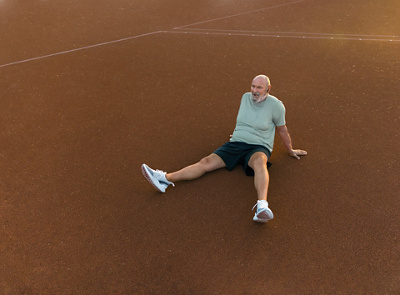Peripheral arterial occlusive disease (PAOD), also known as smoker’s leg or intermittent claudication, is a serious health problem that affects millions worldwide. It occurs when the arteries that transport blood to the legs become narrowed or blocked as a result of atherosclerosis. This results in pain and restricted movement, which may significantly affect quality of life.

An overview of PAOD
PAOD is characterised by a restricted blood supply to the legs caused by arteriosclerosis of the arteries in the leg. These vasoconstrictions or occlusions impair the circulation and increase the risk of infection, which can lead to the formation of skin ulcers and the death of tissue (necrosis). The reduced circulation can lead to pain and cramps in the legs, especially when they are under stress.
Causes and risk factors
Peripheral arterial occlusive disease (PAOD) is a result of arteriosclerosis in the arteries of the leg. In this disease, fat, cholesterol and other substances are deposited in the arterial walls, leading to narrowing and sometimes even complete blockage of the blood vessels. This severely impairs circulation in the legs, which can lead to various health problems.
Risk factors
Arteriosclerosis, the cause of PAOD, is a build-up of plaque within the arteries. This plaque consists mainly of fat, calcium and inflammatory cells, which thicken the arterial walls and reduce the flexibility of the vessels. The following risk factors may lead to the depositing of plaque:
Smoking
Smoking is one of the most significant risk factors with regard to the development of arteriosclerosis and therefore also of PAOD. The chemicals in tobacco smoke promote the building up of plaque and accelerate damage to the arteries.
Diabetes
Diabetes leads to increased blood sugar levels, which may damage the arteries and promote the building up of plaque.
High blood pressure
High blood pressure can damage the arterial walls and promote the formation of plaque.
High cholesterol
High LDL cholesterol levels in the blood promote the depositing of fat in the arterial walls.
Age
The risk of PAOD increases with age, especially after the age of 50.
Sex
Men suffer from PAOD more frequently than women, with the risk for women increasing after menopause.
Family history
Cardiovascular diseases in the family can increase the risk of developing POAD.
Symptoms
The symptoms of peripheral arterial occlusive disease can develop gradually and vary greatly depending on the degree of narrowing or blockage of the arteries. They are often mild at first and can easily be overlooked, but can develop into severe and debilitating symptoms as the disease progresses.
Pain in legs when walking
This is the most characteristic symptom of intermittent claudication. Those affected feel pain and cramps in the legs when walking, which subside when at rest. The pain can be so severe that sufferers have to stand still, which has resulted in the symptom being known in German as “window-shopper’s disease” because sufferers often pause when walking as if they were stopping to look in shop windows.
Feeling of cold and numbness
Those affected may experience a constant feeling of coldness or numbness in the feet or toes, which is often stronger in one leg than in the other.
Skin changes
Pale or bluish, thin, shiny skin, especially on the legs, is another common symptom. The hair on the affected extremities may fall out.
Slowed growth of nails
The toenails may become thicker and grow more slowly.
Wound healing disorders
Even minor injuries or abrasions on the legs or feet may not heal well and may develop into chronic ulcers.
Tissue necrosis
In very severe cases, tissue may die off, which is shown by areas of black or dark discolouration at the extremities.
Diagnosis
The diagnosis of PAOD is issued by a doctor specialising in cardiology and usually begins with a thorough medical history and physical examination, during which the doctor asks about the typical symptoms and checks the pulse points on the legs and feet. A weakened pulse or the lack of a pulse may indicate POAD. The examinations also include measuring the blood pressure in the legs and a radiological examination of the leg arteries with contrast medium, known as an angiography.
Treatment
The aim of the treatment of PAOD is to alleviate the symptoms, improve circulation, and slow down the progression of the disease. At the same time, it is extremely important to avoid smoking. In addition, regular exercise can improve blood circulation. Medication can be used to dilate the arteries and prevent blood clots. Surgical interventions may also be necessary to remove the arterial occlusion. An endarterectomy or a balloon dilation can be used in this case. In severe cases of necrosis, the leg must be saved by means of the amputation of toes or a foot.
Prevention
Prevention of peripheral arterial disease (PAOD) is crucial in order to minimise the development and progression of the disease. The most important preventive measure is a smoke-free lifestyle because smoking impairs circulation and accelerates the narrowing of the arteries. Regular physical exercise, especially endurance training and walking exercises, promotes blood circulation and counteracts arteriosclerosis. A healthy diet including plenty of fruit, vegetables, wholegrain products and unsaturated fatty acids also supports the health of the blood vessels and reduces the absorption of saturated fats and cholesterol.
Regular medical monitoring of cardiovascular health, including the checking of blood pressure, cholesterol and blood sugar, is important in order to identify and treat risk factors at an early stage. Precautionary check-ups that include counselling and patient education can increase awareness of the risks and symptoms of PAOD and contribute to early detection.
Centres 5
-
Vascular Surgery Lucerne LUVAS
Monday to Thursday
08.00 - 12.00 h and 13.00 - 17.00 h
Friday
08.00 - 12.00 h , closed afterwards




